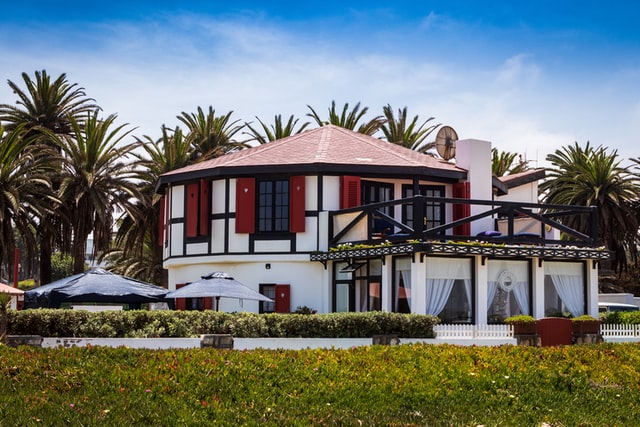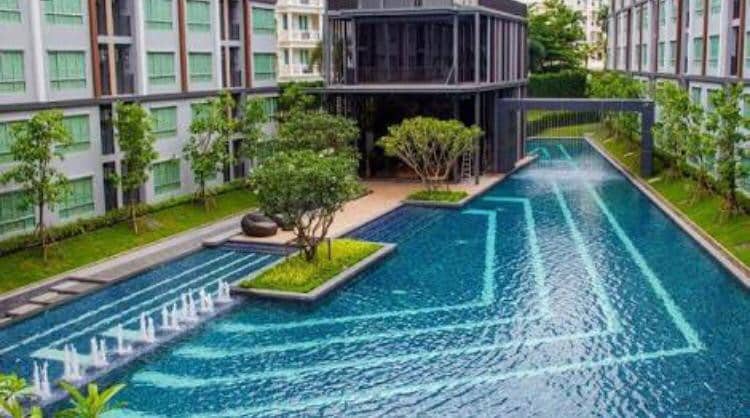This story carries on from our earlier story on property photography. We’ll continue to use this homestay in Kerala as our example.
Quick Checklist for Property Photography
Before you start photographing your property, some preparation is in order.
- Look on the internet and in magazines for pictures of properties that resemble yours. Collect the images you really like.
- Do up your interiors. If you think your property need a facelift, others will, too. For example, in this property, the bedroom has a really grand appearance with the red oxide flooring and the pristine white curtains. However, poor floor planning makes it look awkward. The bedroom would be transformed if the bed is moved so that the headboard is where the wardrobe is now. Adding a traditional Kerala planter’s chair, and replacing the wardrobe with one that complements the bed, and is in the same style, and moving it to where the bed headboard is now, would complete the room.

Use complementary furniture, and plan floor layout optimally - Clean up. Remove everything unnecessary throughout your property. This means no loose papers and magazines lying around; no brooms, mops, and buckets.
- Look at your property. I mean, really look. See how it looks in daytime – in the morning, at noon, in the evening. See if sunrise and sunset make a difference to the way it looks.

Find similar property photos that you like, and use them as inspiration for lighting - Check the lighting. Switch on all the lights at night, and see if you need more. You probably do. In Indian, we tend to not have enough lighting at home.
Lighting is classified into several types: Ambient, task, focal and mood. Indian homes usually have all ambient lighting – lighting that lights up entire rooms. Occasionally, they’ll have some mood lighting – floor lamps and table lamps. See if you have areas that would benefit from focal lighting – bright spots that light up interesting objects of art, paintings and architectural elements. Task lighting is functional lighting – lighting for areas that are assigned for specific purposes, such as kitchen counters and study tables. Not only should all types of lighting be present, they should also be colour-matched. Avoid cool florescent lighting (white tubelights and CFLs) – they do not look good in photographs. If you use tubelights and CFLs, always use “warm” (yellow) bulbs.
- Architectural details, and cultural practices such as lit lamps, add interest to property photos.
After you prepare, I would recommend that you hire a professional photographer. The cost of hiring a professional is easily justified by the increased bookings you’ll get with good pictures on tripvillas.com!
Briefing the photographer
Even with a professional, you’ll want to keep a few things in mind.
- Tell the photographer that you want only “off-camera” lighting. This means that flashes mounted on cameras cannot be used. These produce a flat effect, appropriate for event photography and hectic weddings, but not for homes.
- The photographer should use natural light and your own artificial lighting, and if these are insufficient, use stand-mounted professional lighting.
- Since you’re only looking for a small number of photographs, negotiate beforehand that you’ll only pay per photograph for every picture that you accept.
- Also, try and get a photographer who has some experience with property photography. This may be difficult in a small town, in which case persuade the best photographer you can find to give it a shot.
- Once you retain the photographer, show him the images you collected of similar properties.
The essentials of property photography
Whether or not you use a professional photographer, there are some aspects you have to keep in mind when photographing properties.
POV/Perspective
Point of view, or the point from where you photograph the room, is to my mind the most important decision you’ll make in picturing a room. Where you stand when you take that picture determines if a cozy room looks big, or a big room looks tiny. Similarly, a twin bed can look large, and a king bed small.
With digital cameras, you lose nothing by trying out dozens of angles before you even start the actual photography. Do these tests. Figure out which view of the room flatters it, and use that.
Lighting
As I said earlier, rooms in India tend to be lit poorly. For property photographs, you should have a lot of light. Look at pictures of rooms on hotel sites and in interior design magazines. You’ll see bright, well-balanced lighting. Decide if your room looks better in the day or at night. Then, work on making it look better during that chosen time, with additional lighting.
In case you can’t get the lighting effect you want, your photographer may be able to help you.
Focus
Every photograph you upload to the internet has to be in focus. Blurry, shaken, pixelated pictures may be acceptable among friends on Facebook, but they have no place as part of your official image on the web.
Depth of field
This is related to focus. Due to the way cameras work, in certain cases a part of the image in in focus, and objects in front of and behind that plane are out of focus. Photographers use this technique intentionally to separate the subject from the foreground and the background, but when it happens unintentionally, it may detract from the photo. For property pictures, ideally, everything should be in focus.
Next week, we’ll look at photography without the professionals, tips to get the best property photographs from your personal digital cameras.
To get more information & assistance, please submit the form below and our specialist will get in touch with you at the earliest.








